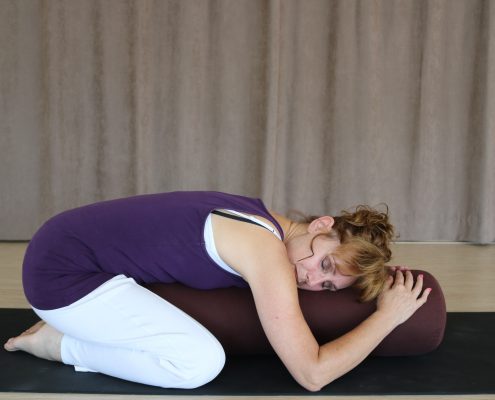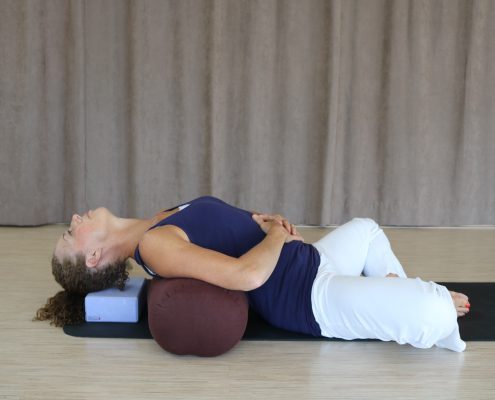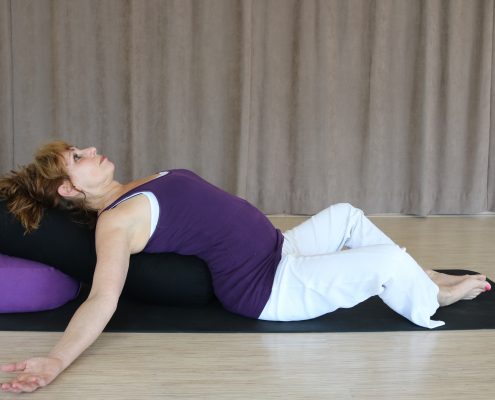Sign up for a trial of 3 classes!
Yin Yoga in Eindhoven at Body Basics Well-being. 
For whom?
Yin Yoga can be practiced by anyone regardless of age or experience. It is mainly about the attention and involvement with which you practice. It is about your own experience.
What is yin yoga?
Yin yoga is rapidly emerging in a short time. The beneficial effects of yin yoga for our daily lives are great: physical, mental and emotional. Yin yoga has a soft, meditative and intense perky character. In contrast to other forms of yoga where the muscle tissue is mainly addressed, yin yoga is about influencing the connective tissue. Within the Taoist system, the connective tissue (fascia) is directly linked to the meridians of the body (the energy pathways).
The effect of yin yoga can be compared with that of acupuncture. The long-term maintenance of a posture purifies and stimulates the meridians, bringing the chi flow into balance.
Release of connective tissue and joints
During yin yoga, the exercises are aimed at relaxing, slowing down and gently stretching and quietly giving pressure on the connective tissue and the joints. This way we lower the stress level and allow our system to release tension that we have built up.
Because connective tissue has a different structure and function than muscles, it is important to deal with it differently.

Muscles can be moved quickly and briefly because they are very agile (yang) and a lot of blood.
Connective tissue contains less blood and has a different structure, making it less mobile (yin).
By going at ease in the posture and holding the asanas for at least three to five minutes, the connective tissue and the joints are slowly stretched and hydrated. This also stretches the muscles (connective tissue is everywhere in our body, so also in and around the muscles, it ensures the connection of our body), while at the same time they remain relaxed.
In addition to an exercise in calm and patience, and wonderful to start and / or finish the day, this specific form of yoga is particularly efficient for (getting back) smooth muscles and vitality. Within yin yoga we assume minimal muscular effort. With minimal effort you make the impact of the posture as big as possible ‘. The postures within yin yoga are primarily intended to stimulate the connective tissue around your hips, pelvis, knees, ankles and spine. Connective tissue produces hyaluronic acid and that attracts moisture, also around tendons of the joints. Not fluid accumulation, as you have with inflamed tissue, but the moisture that forms a kind of jelly between your weights. That makes you move smoothly and freely.
By holding stretch exercises for minutes, you stimulate the connective tissue and restore your mobility and flexibility. Gravity, in combination with your breathing, can then do its job. You can support your body with blankets, pillows and / or blocks. In addition, according to the yogis, we have energy channels (meridians) that run precisely through the pathways of the energy pathways of the connective tissue. If you keep the connective tissue moist, the energy can flow optimally, preventing aging and degeneration.
The intensity of a yin yoga session depends on three things:
- Duration of an asana.

- Temperature of the muscule.
- The patience or perseverance of the yogi.
Paradoxically, it is good to practice yin yoga with non-warmed muscles!
Als de spieren koud zijn, zijn ze minder elastisch en wordt er meer druk uitgeoefend op het bindweefsel, en dat is het doel van yin yoga.
The adventage of Yin Yoga?
- Improve physical and mental strength, flexibility;
- Balances the hormonal system;
- The circulatory system is stimulated, which has a positive effect on the heart;
- The nervous system is positively influenced;
- Digestion is stimulated;
- The drain system (Lymphatic system) is activated;
- Balances your mind and emotions
- Through prolonged stretch promotes the rejuvenation of your fascia (connective tissue).
Origan Yoga The word Yoga comes from Sanskrit and is often referred to as bringing together, unifying, balancing. That can be between body and mind, between thinking and feeling. But also the balance between doing and letting, work and rest, effort and relaxation. Yoga tradition is already at least 5000 years old.
“Breathing in, I calm body and mind. Breathing out, I smile. Dwelling in the present moment I know this is the only moment.”
― Thich Nhat Hanh, Being Peace
Yoga, an ancient but perfect science, is about the evolution of humanity. This evolution includes all aspects of your Being, from physical health to self-realization. Yoga means unity – the oneness of body with consciousness and consciousness with the soul. Yoga cultivates the ways in which you can have a balanced attitude in your daily life and helps you develop skills that help you in carrying out your actions.
B.K.S. Iyengar, Astadala Yogamala
